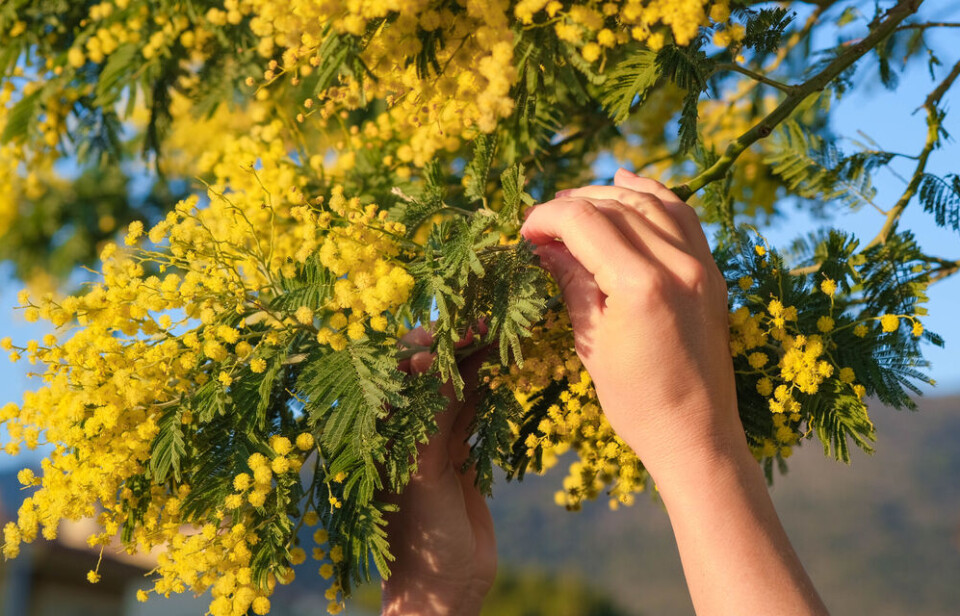-
Veggie burgers and plant-based sausages: French farmers and consumers react to name ruling delay
The EU failed to reach final agreement to draft rules governing plant-based naming
-
Hydroelectric conversions boost demand for historic French watermills
Laws on restoring rivers mean many are now threatened with removal
-
How to identify lounging lizards in France
Learn about the habitats and behaviours of diverse lizard species, from the common wall lizard to the elusive Western three-toed skink
Mimosas blossom in south of France as season begins
The bright, highly-scented trees bloom from January until the end of March, and are prized in the Alpes-Maritimes and Var for everything from perfume to candles to chocolate

Bright yellow mimosa trees are out in force in southern France and are set to last until the end of March, with this year’s bloom expected to be particularly good due to a lack of frost.
Mimosa trees have flowered from January to late March in Provence-Alpes-Côte d'Azur for hundreds of years, after first being imported to the region from Australia in the 18th century.
They have since become somewhat of a regional emblem, and even lend their name to the medieval village of Bormes-les-Mimosas in Var.
Every year, an average of 200 tonnes of the blossom – or 18 million stems – are picked and processed in Alpes-Maritimes and Var. They are used in everything from perfumes to chocolates to sugar syrups, and more.
Several producers grow them and sell the flowers throughout Europe. One such farmer, Julien Cavatore, runs his family business in the area, and cultivates more than 25 varieties of the tree.
He told France 3: “It is a plant that thrives in acidic soil, but the temperature must not fall below 8 degrees [or there is damage]. This year, I think that the harvest will be very good, as we have not had any bad frost episodes that would [otherwise] damage the flowers.”
A #Cannes, le ☀ pousse aussi sur les arbres !
— Cannes, France (@Cannes_France) January 7, 2022
💛 Direction la Croix des Gardes ce week-end pour une balade à travers les mimosas... #CotedAzurFrance pic.twitter.com/Rr0QvdGKZc
The quality of the mimosa tree is not purely based on its flowers, he explains, with the leaves also playing an important role.
At his farm, some varieties produce purple-y or even silvery leaves, or those in a pine needle style.
There are more than 1,200 known varieties of mimosa worldwide. Some rarer types are particularly prized for their distinctive perfume.
Chocolatier Didier Carrié, based in Saint-Raphaël in Var, is among those to favour the flower in seasonal recipes and desserts, France 3 reports.
Laurent Raynaud, creator of artisanal liqueurs and syrups in nearby Théoule-sur-Mer, also uses the flowers in his concoctions. For the past two years has made a limoncello-style drink using mimosa, which he calls “Mimocello”.
He explains: “The flower has an intense scent, but when you eat it, it doesn't have that same flavour. So I created a syrup, because using sugar captures the taste. This is in contrast to grapes, which do not have as strong a scent, until they are in your mouth as wine.”
Around 200 flowers are needed to produce one bottle.
Neither Mr Carrié nor Mr Reynaud use artificial versions of the scent, and pride themselves on using 100% natural flavours from the flowers.
In Australia, where the trees are also popular, the flowers are even roasted and ground, which gives them a flavour that is said to be somewhere between coffee and chocolate, connaisseurs attest.
In Grasse, one perfume shop has recently created a new candle scented with mimosa.
Creator and “scent designer” Karine Deraco explains: “[The scent is] a mix of flowers, wood, and spices. For me, perfume is a tool between people and land. I wanted to use local knowledge in Grasse [to create the scent].”
Such is the tree’s symbolism in the Côte d’Azur, that a 130km tourist route has been created to enable visitors to enjoy the blooms.
It runs throughout eight towns from Var to Alpes-Maritimes: Bormes-les-Mimosas, Grasse, Sainte-Maxime, Saint-Raphaël, Mandelieu-la-Napoule, Tanneron, and Pégomas.
Mimosa trees are visible in gardens and parks along the route, and celebrated in artisanal shops, walks, and even festivals.
The region’s traditional mimosa festival is set to take place in Sainte-Maxime on February 5 and 6, with artisanal stores open on the Saturday, and a parade along the seafront on the Sunday.
Due to Covid, there will be a limit on the number of attendees, although in previous years up to 60,000 visitors have attended.
Related stories
Mediterranean garden in south of France is a winter paradise
Go green: Meet the spirulina producer in France (who even sells soap)
Plants blossom in mild December
French perfumers' secret ingredient
























